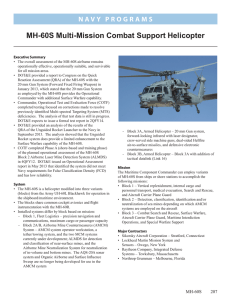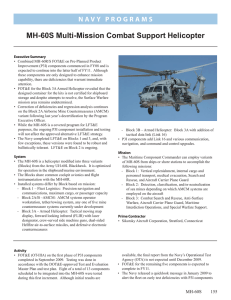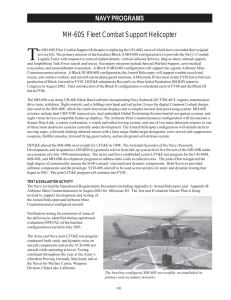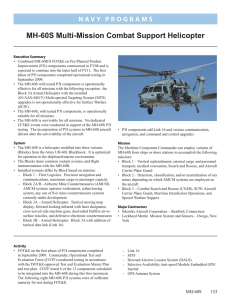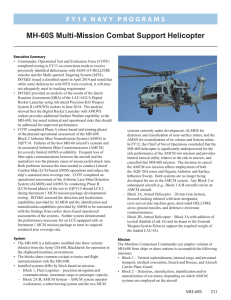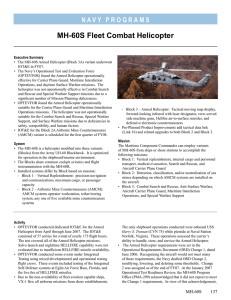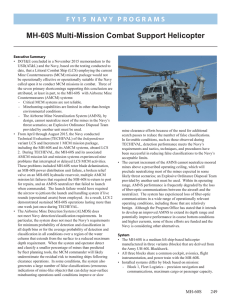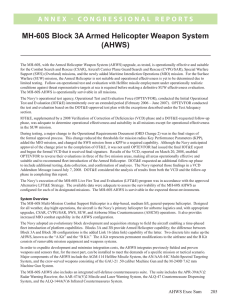N a v y P R O G...
advertisement
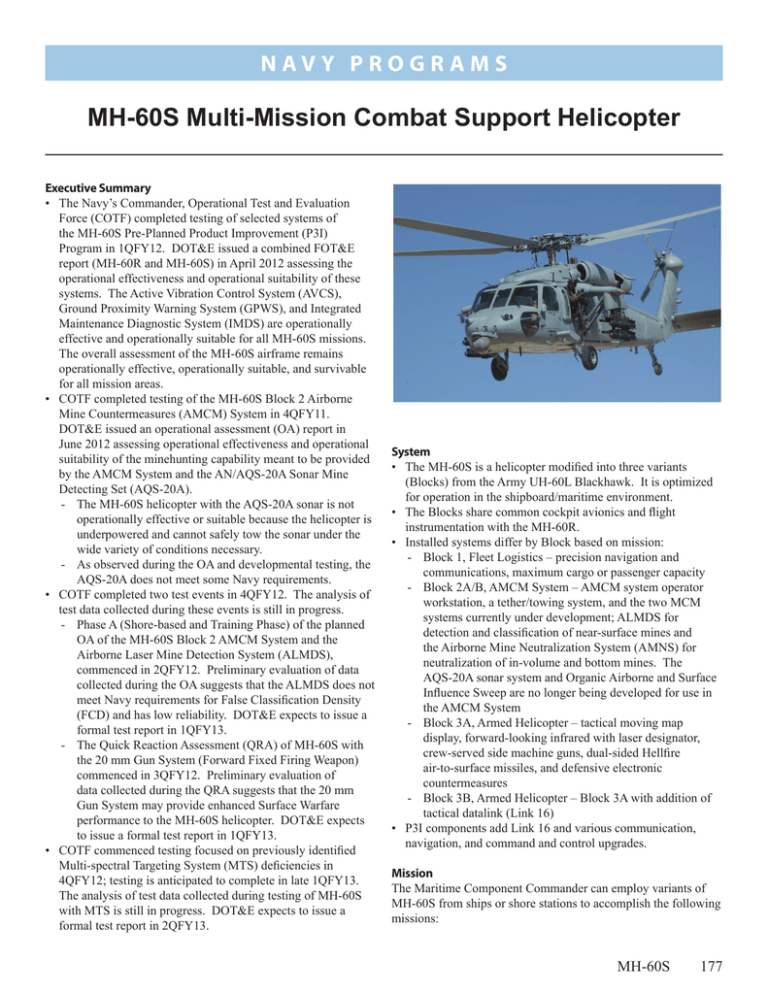
N av y P R O G R A M S MH-60S Multi-Mission Combat Support Helicopter Executive Summary • The Navy’s Commander, Operational Test and Evaluation Force (COTF) completed testing of selected systems of the MH-60S Pre‑Planned Product Improvement (P3I) Program in 1QFY12. DOT&E issued a combined FOT&E report (MH‑60R and MH-60S) in April 2012 assessing the operational effectiveness and operational suitability of these systems. The Active Vibration Control System (AVCS), Ground Proximity Warning System (GPWS), and Integrated Maintenance Diagnostic System (IMDS) are operationally effective and operationally suitable for all MH-60S missions. The overall assessment of the MH-60S airframe remains operationally effective, operationally suitable, and survivable for all mission areas. • COTF completed testing of the MH-60S Block 2 Airborne Mine Countermeasures (AMCM) System in 4QFY11. DOT&E issued an operational assessment (OA) report in June 2012 assessing operational effectiveness and operational suitability of the minehunting capability meant to be provided by the AMCM System and the AN/AQS-20A Sonar Mine Detecting Set (AQS-20A). - The MH-60S helicopter with the AQS-20A sonar is not operationally effective or suitable because the helicopter is underpowered and cannot safely tow the sonar under the wide variety of conditions necessary. - As observed during the OA and developmental testing, the AQS-20A does not meet some Navy requirements. • COTF completed two test events in 4QFY12. The analysis of test data collected during these events is still in progress. - Phase A (Shore-based and Training Phase) of the planned OA of the MH-60S Block 2 AMCM System and the Airborne Laser Mine Detection System (ALMDS), commenced in 2QFY12. Preliminary evaluation of data collected during the OA suggests that the ALMDS does not meet Navy requirements for False Classification Density (FCD) and has low reliability. DOT&E expects to issue a formal test report in 1QFY13. - The Quick Reaction Assessment (QRA) of MH-60S with the 20 mm Gun System (Forward Fixed Firing Weapon) commenced in 3QFY12. Preliminary evaluation of data collected during the QRA suggests that the 20 mm Gun System may provide enhanced Surface Warfare performance to the MH-60S helicopter. DOT&E expects to issue a formal test report in 1QFY13. • COTF commenced testing focused on previously identified Multi-spectral Targeting System (MTS) deficiencies in 4QFY12; testing is anticipated to complete in late 1QFY13. The analysis of test data collected during testing of MH-60S with MTS is still in progress. DOT&E expects to issue a formal test report in 2QFY13. System • The MH-60S is a helicopter modified into three variants (Blocks) from the Army UH-60L Blackhawk. It is optimized for operation in the shipboard/maritime environment. • The Blocks share common cockpit avionics and flight instrumentation with the MH-60R. • Installed systems differ by Block based on mission: - Block 1, Fleet Logistics – precision navigation and communications, maximum cargo or passenger capacity - Block 2A/B, AMCM System – AMCM system operator workstation, a tether/towing system, and the two MCM systems currently under development; ALMDS for detection and classification of near-surface mines and the Airborne Mine Neutralization System (AMNS) for neutralization of in-volume and bottom mines. The AQS-20A sonar system and Organic Airborne and Surface Influence Sweep are no longer being developed for use in the AMCM System - Block 3A, Armed Helicopter – tactical moving map display, forward-looking infrared with laser designator, crew-served side machine guns, dual-sided Hellfire air-to‑surface missiles, and defensive electronic countermeasures - Block 3B, Armed Helicopter – Block 3A with addition of tactical datalink (Link 16) • P3I components add Link 16 and various communication, navigation, and command and control upgrades. Mission The Maritime Component Commander can employ variants of MH-60S from ships or shore stations to accomplish the following missions: MH-60S 177 N av y P R O G R A M S • Block 1 – Vertical replenishment, internal cargo and personnel transport, medical evacuation, Search and Rescue, and Aircraft Carrier Plane Guard • Block 2 – Detection, classification, identification and/or neutralization of sea mines depending on which AMCM systems are employed on the aircraft • Block 3 – Combat Search and Rescue, Surface Warfare, Aircraft Carrier Plane Guard, Maritime Interdiction Operations, and Special Warfare Support Activity • COTF completed testing of the AVCS, GPWS, and IMDS improvements in 1QFY12. DOT&E issued a combined FOT&E report (MH-60R and MH-60S) in April 2012 assessing the operational effectiveness and operational suitability of these systems. • COTF completed testing of the MH-60S Block 2A AMCM System and the AQS-20A in 4QFY11. DOT&E issued an OA report in June 2012 assessing operational effectiveness and operational suitability of the minehunting capability. • COTF commenced Phase A (Shore-based and Training Phase) of the planned OA of the MH-60S Block 2 AMCM System and the ALMDS in 2QFY12; testing completed in 4QFY12. The Navy postponed conduct of Phase B (Littoral Combat Ship (LCS) Ship-based Phase) of the planned OA due to the unavailability of an LCS seaframe to facilitate conduct of MCM mission module testing. The Navy intends to conduct the LCS ship-based phase of the planned ALMDS and AMNS OAs in conjunction with the LCS Technical Evaluation scheduled to occur in FY14. • COTF conducted all testing in accordance with the DOT&E‑approved test plan. • COTF commenced a QRA of MH-60S with the 20 mm Gun System (Forward Fixed Firing Weapon) in 3QFY12; testing completed in 4QFY12. COTF conducted the assessment in accordance with the DOT&E-approved data management and analysis plan. • COTF commenced testing of previously identified deficiencies of the MH-60S with MTS in 4QFY12. COTF conducted the testing in accordance with a DOT&E-approved data management and analysis plan. Testing is anticipated to complete in 1QFY13. • All LFT&E activities have been completed and reported in the LFT&E report to Congress in 2008. Assessment • The AVCS, GPWS, and IMDS are assessed to be operationally effective and operationally suitable for all MH-60S missions. There were no significant operational effectiveness deficiencies identified during testing. The test results did not affect any prior findings on the overall operational effectiveness, operational suitability, or survivability of the MH-60S airframe in any mission area. 178 MH-60S Major Contractors • Sikorsky Aircraft Corporation – Stratford, Connecticut • Lockheed Martin Mission System and Sensors – Owego, New York • Raytheon Company, Integrated Defense Systems – Tewksbury, Massachusetts • Northrop Grumman Corporation – Melbourne, Florida • The MH-60S helicopter and AQS-20A sonar are not operationally effective or suitable because the helicopter is underpowered and cannot safely tow the sonar under the variety of conditions necessary. The Chief of Naval Operations recently concluded that the MH-60S helicopter is significantly underpowered for the safe performance of the AMCM tow mission and provides limited tactical utility relative to the risk to aircrew, and cancelled that MH-60S mission. The decision to cancel the AMCM tow mission affects employment of both the AQS-20A sonar and Organic Airborne and Surface Influence Sweep. • As observed during the OA and developmental testing, the AQS-20A does not meet all Navy requirements in all operating modes. Contact depth (vertical localization) errors exceeded Navy limits in all AQS-20A operating modes. FCD also exceeded Navy limits in two of three search modes. • The analysis of test data collected during Phase A of the OA of the MH-60S and ALMDS is still in progress. Preliminary evaluation of data collected during the OA suggests that the ALMDS does not meet Navy requirements for FCD or reliability. DOT&E expects to issue a formal test report in 2QFY13. Phase B testing was originally intended to provide early operational testing insight into the operational effectiveness and suitability of AMCM systems when operating from an LCS, and to identify risk to the successful completion of IOT&E. However, the Navy’s cancellation of Phase B testing will eliminate these intended benefits. • The analysis of test data collected during the QRA of MH-60S with the 20 mm Gun System (Forward Fixed Firing Weapon) is still in progress. Preliminary evaluation of data collected during the QRA suggests that the 20 mm Gun System may provide enhanced Surface Warfare performance to the MH‑60S helicopter. DOT&E expects to issue a formal test report in 1QFY13. • The analysis of test data collected during testing of MH-60S with MTS is still in progress. The scope of the testing was focused on previously identified MTS deficiencies. The testing was not designed to assess Surface Warfare mission capability of MH-60S when equipped with MTS and the Hellfire missile. DOT&E expects to issue a formal test report in 2QFY13. N av y P R O G R A M S Recommendations • Status of Previous Recommendations. The Navy satisfactorily addressed 8 of the 11 previous recommendations. The Navy should still: 1. Investigate solutions and correct AN/AQS-20A FCD and Vertical Localization deficiencies prior to IOT&E. 2. Investigate solutions and correct the ALMDS FCD deficiency prior to IOT&E. 3. Conduct LCS ship-based phases of the planned OA of the MH-60S Block 2 and ALMDS as well as an OA of the MH-60S Block 2 and AMNS MCM systems in FY13 to reduce risk to the LCS MCM Mission Package IOT&E. • FY12 Recommendation. 1. The Navy should plan to conduct FOT&E to assess MH‑60S’s surface warfare capability when equipped with MTS and the Hellfire missile. MH-60S 179 N av y P R O G R A M S 180
